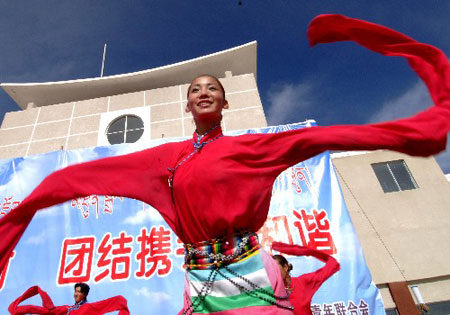The Tibet Autonomous Regional Government has attached great importance to cultural development in rural areas, and spared no effort to carry out a program delivering cultural services to the areas.

Photo taken on Feb. 6, 2007 shows a dancer performing for farmers and herders during a cultural service activity. On the same day, a campaign delivering cultural services to rural areas organized by the Communist Youth League Committee of Tibet Autonomous Region was launched in Panam County, Xigaze Prefecture, Tibet, photo from Xinhua.
Every year the regional government launches twice on a large scale activities to deliver cultural service to the rural areas providing drama shows, movies and books. Departments concerned also organize theatre troupes to give regular shows.
Teams are set up in counties to provide radio and television-related services, improving the rural radio and television public service network.
Concerned about the unavailability of movies to farmers and herders, the regional government has stepped up services in this regard. As a result, more mobile movie projection vehicles are sent down, with the number of movie shows put on in rural areas increasing to 120,000 annually.

Photo taken on Feb. 6, 2007 shows a technician passing on vegetable planting skills to a farmer during a cultural service activity launched in Panam County in Tibet's Xigaze Prefecture organized by the Communist Youth League Committee of Tibet Autonomous Region, photo from Xinhua.
The government also plans to step up digital cultural information service in grazing areas. Cultural activity centers on county and township levels are to be built to ensure that each county and township in Tibet has one of them.
Moreover, the regional departments of press and publishing, television and broadcasting, culture, arts have all given top priority to implementing this cultural service program, and been making efforts accordingly.
In their efforts, the Tibetan version of Tibet Daily is delivered for free to villages and monasteries; Tibetan People's Radio and Tibet Television Station broadcast more shows and programs catering to the rural audience; departments of culture and arts began the work to sort out cultural information resources of excellence, digitalize them and translate them into Tibetan language.
